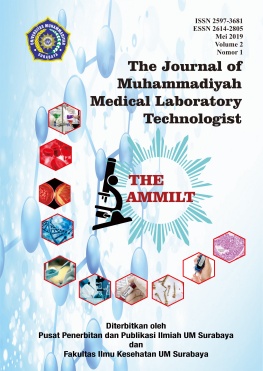Isi Artikel Utama
Abstrak
Salicylic acid is a substance that is often added to skin care products for acne. In the regulation of the National Agency of Drug and Food Control No. Hk.03.1.23.08.11.07517 in 2011 concerning the technical requirements of cosmetics, salicylic acid levels are limited to 3% for rinse production and 2% for other production and are not used for children under 3 years. Using at high doses can cause the baby to bleed, mute and deaf. This is because the structure of the baby's skin is still thin, so it becomes susceptible to irritation and infection. The title of this research is Analysis of Salicylic Acid in the mains supplies barnded baby in the market blauran in Surabaya Region. The purpose identified salicylic acid content with qualitative tests on baby cosmetics circulating in Surabaya. The formulation of this problem is the presence or absence of Salicylic Acid in baby cosmetics. The type of research used descriptive, there were 26 baby cosmetics products in 4 types of products in the form of powder, soap, shampoo, and lotion which were conducted in the Laboratory of Muhammadiyah University of Surabaya in June 2018. Based on the results that found from 26 samples of baby cosmetics in the form of powder as much as 100% of soap, shampoo and lotions sold in Surabaya were not found for Salicylic Acid. So that all samples met the requirements based on the regulation of the National Agency of Drug and Food Control No.Hk.03.1.23.08.11.07517 in 2011 concerning the technical requirements of cosmetics materials, salicylic acid levels were limited to 3% not used for children under 3 years.
          Keywords: Baby supplies, Salicylic Acid
Rincian Artikel
Referensi
- Anonim, 2015. Langkah Cerdas Memilih Kosmetik,
- http://www.pom.go.id/new/index.php/view/berita/8264/Langkah-Cerdas-Memilih-Kosmetik.html(Diakses 15 Juni 2017).
- Ansel, H.C, 1989. Pengantar Bentuk Sediaan Farmasi Edisi Keempat. Penerbit Jakarta Universitas Indonesia.
- Arfina, 2013. Analisis Kandungan Rhodamin B Pada Kosmetik Perona Pipi Yang
- Beredar Di Pasar Tradisional Kota Makasar. http://repositori.uin-alauddin.ac.id/3018/1/ARFINA.pdf (Diakses 20 Juli 2018).
- Astuti, Y.I., Sudirman, I., dan Hidayati, U. (2007): Pengaruh Konsentrasi Adaps Lanae Dalam Dasar Salep Cold Cream Terhadap Pelepasan Asam Salisilat, Pharmacy, Vol. 05,Universitas Muhammadiyah Purwokerto.
- Badan POM RI, 2009, Publik Warning/Peringatan tentang Kosmetik Mengandung Bahan Berbahaya/Bahan Dilarang, Jakarta.
- BPOM Republik Indonesia. 2011. Peraturan Kepala Badan Pengawasan Obat dan Makanan No. Hk.03.1.23.08.11.07517 Tahun 2011 tentang Persyaratan Teknis Bahan Kosmetika.
- Damayuda, 2010.http://damayuda.kimia-organik.com/2010/12/asam-salisilat-
- c7h6o2.pdf . (Diakses 31 Juli).
- Departemen Kesehatan Republik Indonesia. 1979. Farmakope Indonesia. Edisi III.
- Jakarta: Departemen Kesehatan RI.
- Dep Kes RI, 1988, Pedoman Pengujian Mutu Sediaan Rias, Jakarta.
- Dirjen POM, 1985.Formularium Kosmetika Indonesia. Departemen Kesehatan RI.
- Djajadisastra, 2005. Tekhnologi Kosmetik. Tangerang : Departemen Farmasi FMIPA Universitas Indonesia.
- http://ik.pom.go.id/v2016/katalog/Asam%20Salisilat.pdf. (Diakses 7 Juli 2018).
- Irwandi, Dedi. 2014. Experient’s of Organic Chemical. Jakarta : UIN Press.
- Jaelani, 2009. Ensiklopedi Kosmetika Nabati Edisi 1. Penerbit Pustaka Populer Obor. Jakarta.
- PerMenkes RI, 2010. Menteri Kesehatan Republik Indonesia Nomor 1175/MenKes/PER/VIII/2010 Tentang Izin Produksi Kosmetika, Jakarta.
- Putridiniati,2013.http://putridiniati.blogspot.com/2013/03/sifat-keasaman-dan-kebasaan-turunan.pdf. (Diakses 10 juli).
- Soeryati, Sri, 2002. Sediaan kosmetika, departemen pendidikan nasional Unpad, Bandung.
- Sulistyaningrum, K.S., Nilasari, H., dan Effendi, H.E. (2012): Penggunaan Asam
- Salisilat dalam Dermatologi, J Indon Med Assoc, Volum: 62, Nomor: 7.
- Tjsianturi, 2013. Penetapan Kadar Asam
- Salisilat.http://tjsianturi.blogspot.com/2013/11/penetapan-kadar-asam-
- salisilat-dalam.html.(Diakses 28 juli).
- Tranggono, RI. Dan Fatma Latifah, 2007. Buku Pegangan Ilmu Pengetahuan Kosmetik. Penerbit Pustaka Utama, Jakarta.
- Wasitaatmadja, S. M, 2002. Penuntun Ilmu Kosmetik Medik. Penerbit Universitas Indonesia.
Referensi
Anonim, 2015. Langkah Cerdas Memilih Kosmetik,
http://www.pom.go.id/new/index.php/view/berita/8264/Langkah-Cerdas-Memilih-Kosmetik.html(Diakses 15 Juni 2017).
Ansel, H.C, 1989. Pengantar Bentuk Sediaan Farmasi Edisi Keempat. Penerbit Jakarta Universitas Indonesia.
Arfina, 2013. Analisis Kandungan Rhodamin B Pada Kosmetik Perona Pipi Yang
Beredar Di Pasar Tradisional Kota Makasar. http://repositori.uin-alauddin.ac.id/3018/1/ARFINA.pdf (Diakses 20 Juli 2018).
Astuti, Y.I., Sudirman, I., dan Hidayati, U. (2007): Pengaruh Konsentrasi Adaps Lanae Dalam Dasar Salep Cold Cream Terhadap Pelepasan Asam Salisilat, Pharmacy, Vol. 05,Universitas Muhammadiyah Purwokerto.
Badan POM RI, 2009, Publik Warning/Peringatan tentang Kosmetik Mengandung Bahan Berbahaya/Bahan Dilarang, Jakarta.
BPOM Republik Indonesia. 2011. Peraturan Kepala Badan Pengawasan Obat dan Makanan No. Hk.03.1.23.08.11.07517 Tahun 2011 tentang Persyaratan Teknis Bahan Kosmetika.
Damayuda, 2010.http://damayuda.kimia-organik.com/2010/12/asam-salisilat-
c7h6o2.pdf . (Diakses 31 Juli).
Departemen Kesehatan Republik Indonesia. 1979. Farmakope Indonesia. Edisi III.
Jakarta: Departemen Kesehatan RI.
Dep Kes RI, 1988, Pedoman Pengujian Mutu Sediaan Rias, Jakarta.
Dirjen POM, 1985.Formularium Kosmetika Indonesia. Departemen Kesehatan RI.
Djajadisastra, 2005. Tekhnologi Kosmetik. Tangerang : Departemen Farmasi FMIPA Universitas Indonesia.
http://ik.pom.go.id/v2016/katalog/Asam%20Salisilat.pdf. (Diakses 7 Juli 2018).
Irwandi, Dedi. 2014. Experient’s of Organic Chemical. Jakarta : UIN Press.
Jaelani, 2009. Ensiklopedi Kosmetika Nabati Edisi 1. Penerbit Pustaka Populer Obor. Jakarta.
PerMenkes RI, 2010. Menteri Kesehatan Republik Indonesia Nomor 1175/MenKes/PER/VIII/2010 Tentang Izin Produksi Kosmetika, Jakarta.
Putridiniati,2013.http://putridiniati.blogspot.com/2013/03/sifat-keasaman-dan-kebasaan-turunan.pdf. (Diakses 10 juli).
Soeryati, Sri, 2002. Sediaan kosmetika, departemen pendidikan nasional Unpad, Bandung.
Sulistyaningrum, K.S., Nilasari, H., dan Effendi, H.E. (2012): Penggunaan Asam
Salisilat dalam Dermatologi, J Indon Med Assoc, Volum: 62, Nomor: 7.
Tjsianturi, 2013. Penetapan Kadar Asam
Salisilat.http://tjsianturi.blogspot.com/2013/11/penetapan-kadar-asam-
salisilat-dalam.html.(Diakses 28 juli).
Tranggono, RI. Dan Fatma Latifah, 2007. Buku Pegangan Ilmu Pengetahuan Kosmetik. Penerbit Pustaka Utama, Jakarta.
Wasitaatmadja, S. M, 2002. Penuntun Ilmu Kosmetik Medik. Penerbit Universitas Indonesia.

